Inhalation of Shin-I essential oil enhances lactate clearance in treadmill exercise
Hsuan-Ying Chen, Ming-Fu Wang, Jun-Ying Lin, Ying-Chieh Tsai, Fu-Chou Cheng
1Stem Cell Center, Department of Medical Research, Taichung Veterans General Hospital, 1650, Sect. 4, Taiwan Boulevard, Taichung, 40705, Taiwan
2Department of Food and Nutrition, Providence University, 200, Sec. 7, Taiwan Boulevard, Shalu Dist., Taichung, 43301, Taiwan
3Yangsen Biotechnology Co., Ltd. 3F, 5, Sec.1, Bei-tou.Rd., Bei-tou, Taipei, 11245, Taiwan
4Institute of Biochemistry and Molecular Biology, National Yang-Ming University, 155, Sec.2, Li-nong Street, Taipei, 11221, Taiwan
Inhalation of Shin-I essential oil enhances lactate clearance in treadmill exercise
Hsuan-Ying Chen1,2, Ming-Fu Wang2, Jun-Ying Lin3, Ying-Chieh Tsai4, Fu-Chou Cheng1*
1Stem Cell Center, Department of Medical Research, Taichung Veterans General Hospital, 1650, Sect. 4, Taiwan Boulevard, Taichung, 40705, Taiwan
2Department of Food and Nutrition, Providence University, 200, Sec. 7, Taiwan Boulevard, Shalu Dist., Taichung, 43301, Taiwan
3Yangsen Biotechnology Co., Ltd. 3F, 5, Sec.1, Bei-tou.Rd., Bei-tou, Taipei, 11245, Taiwan
4Institute of Biochemistry and Molecular Biology, National Yang-Ming University, 155, Sec.2, Li-nong Street, Taipei, 11221, Taiwan
PEER REVIEW
Peer reviewer
Dr. Ying Shih, Professor, Department of Cosmetic Science, Providence UniversityTaichung, Taiwan.
Tel: +886-4-2632-8001 Ext. 15471
Fax: +886-4-2631-1167
E-mail: yingshih@pu.edu.tw
Comments
The mechanisms of some wellknown effects of essential oils on physiological and psychological disorders have not been clearly established. This study provides evidence-base data and suggests that Shin-I essential oil inhalation may accelerate recovery after exercise in rats. In addition, lactate clearance is significantly enhanced after Shin-I aromatherapy.
Details on Page 162
Objective:To evaluate the effect of Shin-I essential oil inhalation on blood lactate changes in rats subjected to treadmill exercise.
Blood, Lactate, Shin-I essential oil, Treadmill exercise
1. Introduction
Exercise results in a depletion of blood glucose and an accumulation of blood lactate concentrations[1]. Numerous studies have indicated that glucose and lactate concentrations are closely correlated with exercise intensity[2]. In general, the onset or threshold of blood lactate represents the balance between lactate production and removal and may not suggest the efficiency of aerobic or anaerobic metabolism. However, lactate production is considered to be one of the major causes of muscle fatigue during exercise. Lactate appears to be an importantsource of systemic energy and plays an important role in providing optimal conditions for anaerobic exercise[3]. In addition, lactate accumulation reflects a mismatch between the inefficient rapid ATP production by glycogenolysis and the oxidative processes. The interference with muscle contraction and metabolism during this mismatch may result in the inhibition of oxidative phosphorylation[4]. Lack of oxidative phosphorylation is generally accepted to be one of the critical factors in muscle fatigue. Meanwhile, the clearance of lactate is crucial to allow the muscle to continue working. Previous studies found that lactate clearance was enhanced when performing continuous exercise or massage during recovery periods[5-7]. Among these methods, massage and aromatherapy have been shown to provide an efficient relief from muscle fatigue[6,7].
Aromatherapy has been used for thousands of years as a folk remedy and has become popular in complementary and alternative medicine in recent years[8]. Shin-I (or Flos Magnolia) is a commonly used Chinese medicinal herb, and it is one of the most widely used essential oils. Shin-I has been traditionally used for the treatment of allergic rhinitis, nasal empyema, sinusitis, hypotension and fungal infection, as well as for its skeletal muscle contracting effects[9,10]. Although aromatherapy is widely used, there is little scientific evidence in support of its efficacy as a therapeutic agent.
Our previous studies have used our auto-blood sampling system to explore dynamic changes of energy metabolites during exercise in animal models[1,11]. The aim of the present study was to investigate the effects of the inhalation of Shin-I essential oil on dynamic lactate changes in rats by using the auto-sampling system after treadmill exercise. Blood lactate accumulation and clearance were evaluated.
2. Materials and methods
2.1. Preparation of Shin-I essential oil
The Shin-I essential oil was extracted by conventional steam distillation from the buds ofMagnolia biondiiPamp (Nanzhao County, Henan, China). In brief, 200 g of fresh buds ofMagnolia biondiiPamp were ground and mixed with 3 000 mL of water. The temperature of the steam decomposed the plant fibers sufficiently to expose the essential oil molecules, which were then carried by the water vapor up and out of the container. The steam/oil mixture was then cooled via a Liebig condenser at 4 °C to obtain the essential oil, which was then analyzed by gas chromatography (GC)-mass spectrometry (MS) analysis.
2.2. GC-MS analysis
Essential oil extract (1 μL) was analyzed by GC-MS using an Agilent 6890N GC interfaced with a Hewlett-Packard 5973 MS. A Zebron-5 mass cross-linked fused-silica capillary column (HP-5MS, 0.25 mm×30 m) coated with 5% phenyl polymethylsiloxane (0.25 μm thickness) was used. The oven temperature was maintained at 40 °C, then increased from 40 to 100 °C (2 °C/min), and then increased from 100 to 250 °C (7 °C/min), and finally maintained at 250 °C for 10 min. The pressure of the helium inlet was set at 11.57 pounds per square inch, with a linear velocity of 33 cm/s. The injector temperature was maintained at 250 °C. The percentage composition of the essential oils was computed from GC peak areas. Chromatographic peaks were checked for homogeneity with the aid of mass chromatograms of characteristic fragment ions. The Wiley NIST database was used for automatic identification of the GC peaks.
2.3. Animals
Adult male Sprague Dawley rats (300-350 g) were purchased from BioLASCO Taiwan Co., Ltd. (Taipei, Taiwan). All rats were housed in a temperature-(25 °C) and lightcontrolled room (12:12 h light-dark cycle), with standard rat chow and waterad libitum. Animal care and experimental procedures were approved by the Institutional Animal Care and Use Committee of Taichung Veterans General Hospital (La-97524) in accordance with the guidelines for use of laboratory animals. Rats (n=12) were randomly separated into the control or the Shin-I group. Each rat was anesthetized by isoflurane (Anaesthesia Unity, Univentor 400; Phymep, Paris, France), and a catheter (TPC/40, EICOM, Kyoto, Japan) was inserted into the jugular vein for repeated blood samplings. To prevent the TPC/40 catheter from injuring the rats, the catheter was tunneled under the rat’s skin to the nape of the back of the neck. Blood samples (50 μL) were automatically collected every 15 min via the implanted catheter in the jugular vein by the auto-blood sampling system (DR-II, EICOM, Kyoto, Japan). Blood samples were centrifuged at 3 000 r/min for 10 min at 4 °C. A microdialysis analyzer (CMA/600, Carnegie Medicin, Stockholm, Sweden) was employed for determination of glucose and lactate concentrations. Glucose and lactate are oxidized by glucose and lactate oxidase, respectively. Peroxidase catalyses the reaction between the hydrogen peroxidase formed, phenol, and 4-amino-antipyrineto form the red-violet colored quinoneimine, which was detected at 546 nm.
2.4. Treadmill exercise
All rats were habituated to the treadmill apparatus (Model T306, Diagnostic & Research Instruments Co., Taoyuan, Taiwan). Following a 60-min initial period (basal levels), each rat was subjected to exercise at a speed of 15 m/min for 30 min, and an electric shocking grid on the rear barrier was also employed to encourage running. After exercise, 200 μL of water or Shin-I essential oil was vaporized using a nebulizer during the 180-min recovery period (Figure 1).
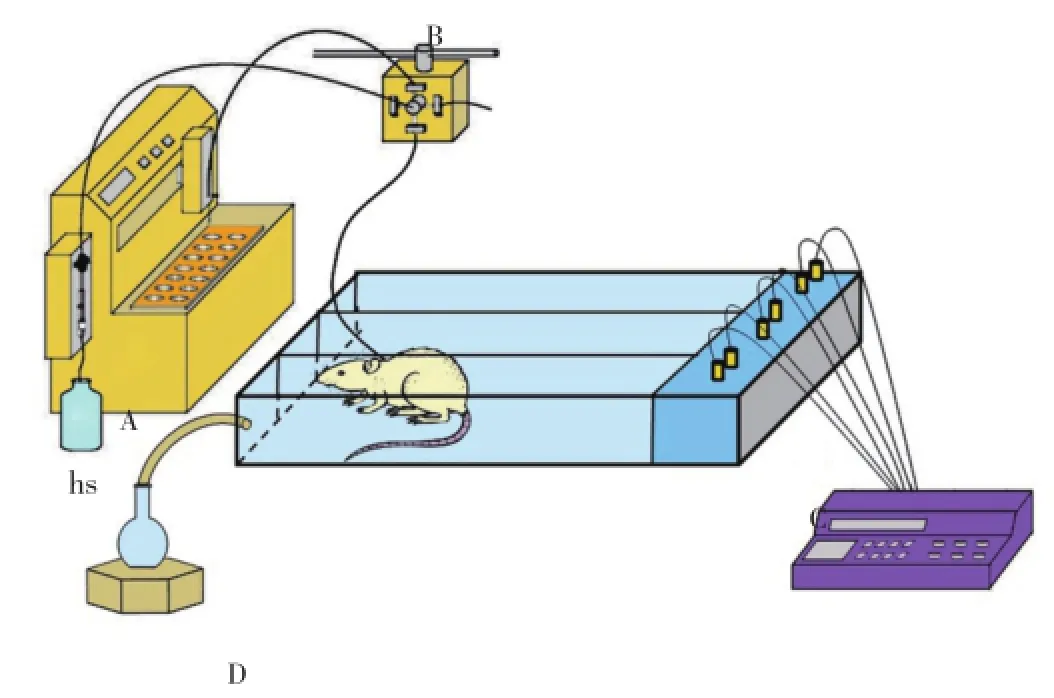
Figure 1. Schematic of a rat on the exercise treadmill connected to the auto-blood sampling system. The speed of the treadmill was set according to experimental protocol. Blood sampling was performed during treadmill exercise. Water or Shin-I essential oil was vaporized using a nebulizing diffuser during the rest period on the treadmill apparatus.A: Auto-blood sampling system and syringe unit; B: 5-way joint unit of the auto-blood sampling system; C: Treadmill apparatus; D: Nebulizing diffuser.
2.5. Lactate clearance
The lactate clearance was calculated as follows: lactate clearance (%)=(The difference in lactate concentration between after running and after 60 min rest)/(the lactate concentration after 60 min rest) ×100[12].
2.6. Statistical analysis
All data were expressed as mean±SEM. The Mann-Whitney test and Wilcoxon signed-ranks test were performed to compare differences between and within groups, respectively. All analyses were performed using the statistical package for the social sciences software (SPSS 14.0).P<0.05 were considered significant.
3. Results
3.1. Determination of the constituents of Shin-I essential oil
The Shin-I essential oil was identified in the GC-MS analysis by means of the mass spectral fragmentation patterns (Wiley 275.L & NIST 98.L). A typical chromatogram and fourteen chemical components were characterized in Shin-I essential oil, as shown in Figure 2 and Table 1, respectively. The major components were 1,8-cineole (38.95%), sabinene (14.04%), α-pinene (8.56%), 2-β-pinene (7.21%), and γ-terpinene (4.17%).
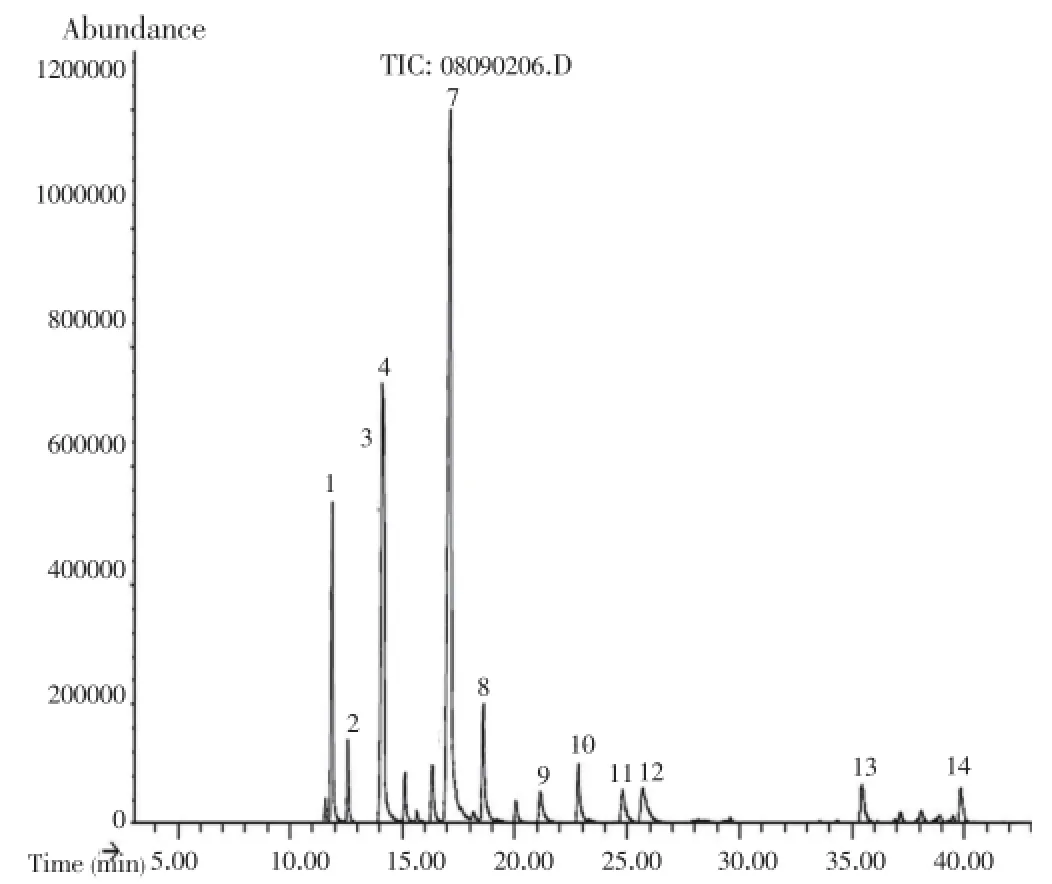
Figure 2. A typical GC-MS chromatogram of Shin-I essential oil.
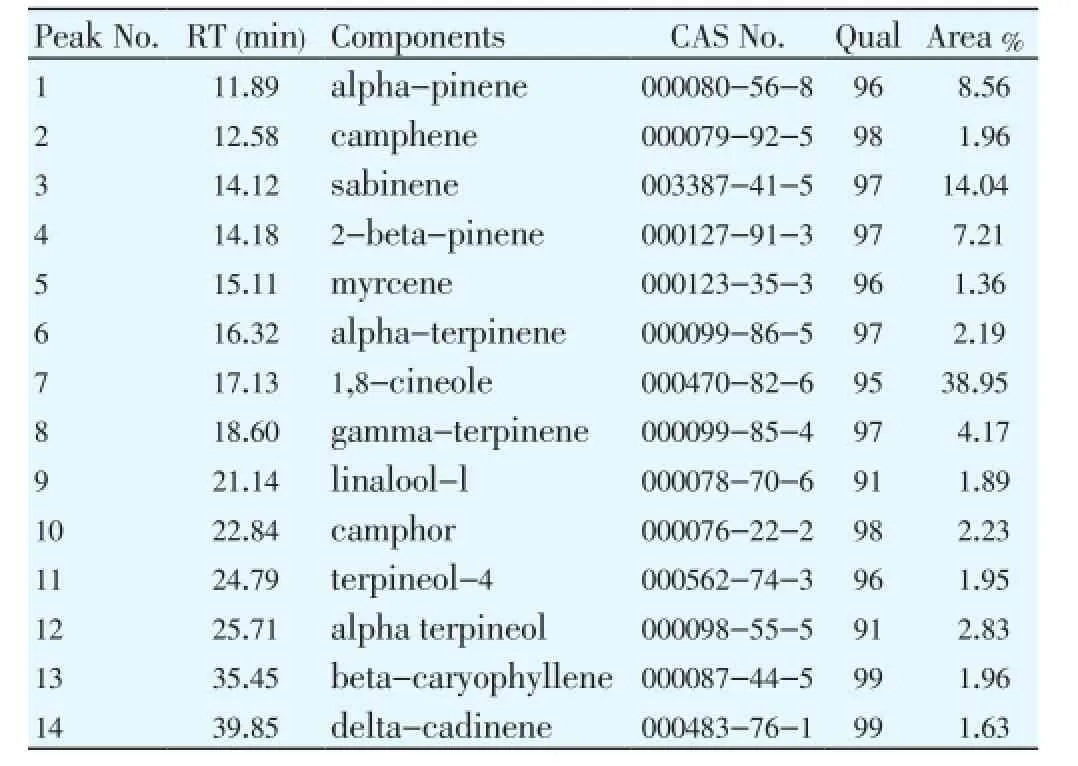
Table 1 Major components of Shin-I essential oil identified by GC-MS.
3.2. Analysis of energy metabolites
The basal concentrations of glucose were (5 070±94) μmol/ L and (5 372±206) μmol/L in the control and Shin-I groups, respectively (Figure 3). There was no significant difference in basal values between the two groups. Glucose concentrations were slightly increased to 115% of the basal level during the exercise period, which then decreased to the basal level in the recovery period in both groups.
The lactate concentrations were about (736±58) μmol/L and (646±25) μmol/L in the control and the Shin-I groups,respectively (Figure 4). There was no difference in basal levels between the two groups. Lactate concentrations significantly increased (P<0.05 when compared to the basal level) to about 130% during the exercise period. Lactate concentrations further increased to around 180% and then remained at a plateau in the recovery period in the control group. However, lactate concentrations increased to a peak of 150% in the initial 30 min of the recovery period, and then gradually decreased to the basal level in the Shin-I group (Figure 4).
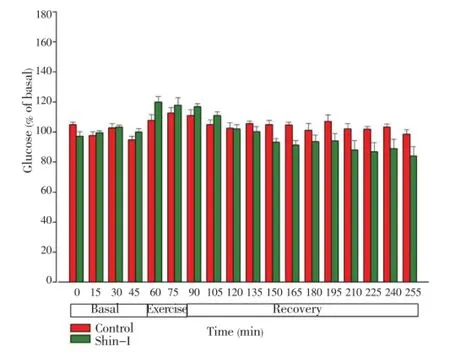
Figure 3. Time profiles of the changes in blood glucose at basal level, during running and during the recovery period in treadmill exercise with the speed set at 15 m/min for 30 min.
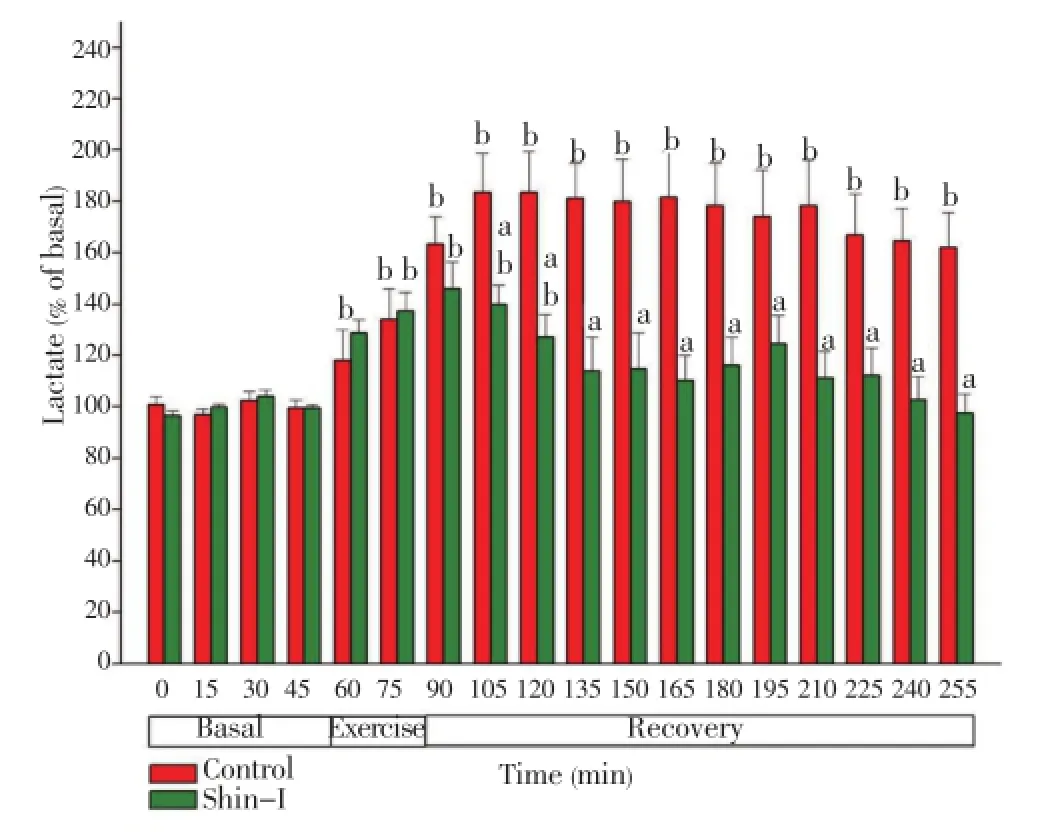
Figure 4. Time profiles of the changes in blood lactate concentration at basal level, during running and during the recovery period in treadmill exercise with the speed set at 15 m/min for 30 min.aP<0.05 compared with the control group, Mann-Whitney Test;bP<0.05 compared with the basal level, Wilcoxon signed-ranks test.
Lactate clearances were -42% and 25% in the control and the Shin-I groups, respectively, as shown in Figure 5. The lactate clearance of the Shin-I group was significantly higher (P<0.05) when compared to that of the control group.
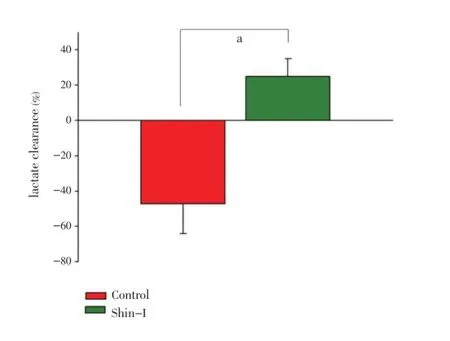
Figure 5. The lactate clearance after rest in rats with or without Shin-I essential oil inhalation.aP<0.05 compared with the control group, Mann-Whitney Test. Lactate clearance=(The difference in lactic acid concentration between after running and after 60 min rest)/(the lactic acid concentration after 60 min rest)×100.
4. Discussion
Inhalation of Shin-I essential oil after exercise dramatically affected the dynamic changes of lactate profiles and effectively enhanced lactate clearance in rats. However, the glucose concentrations were still maintained around the basal level.
In general, glycogen breaks down to produce glucose, and glucose is transported across the blood flow to the exercising muscle for energy support during exercise. Glucose is oxidized to pyruvate or lactate in muscle. Moreover, excess muscle lactate is removed by blood flow and transported to the liver for gluconeogenesis or re-use as an energy source[4]. Thus, blood glucose and lactate concentrations raise following blood flow caused by exercise. The present data reflected this phenomenon. In addition, muscle lactate clearance capacity is critical after exercise, because the threat of acidosis is the main factor in oxidative phosphorylation arrest[4]. In several studies, lactate is effectively eliminated by recovery after exercise (e.g. continuous jogging, massage, active or passive exercise) when compared with the resting group[13]. It is interesting to note in current study that blood lactate concentrations were significantly decreased by inhalation of Shin-I essential oil for 30 min during the recovery period (Figure 4,P<0.05). Lactate clearance (lactic acid clearance) was used to assess the removal of lactate after 60 min rest, based on the method described by Wanget al[12]. The lactate clearance of the Shin-I group was greater than that of the control group (Figure 5,P<0.05). Taken together, these results suggest that inhalation of Shin-I essential oil may effectively enhancelactate clearance by increasing blood flow after treadmill exercise.
However, it is unclear from previous research that what roles Shin-I essential oil plays in energy metabolism. We analyzed the main chemical components of the Shin-I essential oil, and identified them as follows: 1,8-cineole, sabinene, α-pinene, 2-β-pinene, and γ-terpinene (Table 1). Among these components, 1,8-cineole (38.95%) was the major component in the extract. Studies suggested that 1,8-cineole probably has pharmacological effects and the blood flow is significantly increased after inhalation of the fragrance[14,15]. 1,8-cineole is quickly absorbed via nasal mucus after inhalation for 20 min and the fragrance could activate the olfactory center, further affecting the secretion of neurotransmitters in the brain[16,17].
Previous studies have investigated the effects of essential oil extracts on immune regulation, and anti-inflammationin vitro[18-20]. In addition, some investigations have evaluated the effects of inhalation on physiological variables, such as blood pressure, mean arterial pressure, maximum heart rate, spirometry parameters and subjective feelings (by questionnaire)[7,21-23]. Research found that essential oil can relax the bronchial smooth muscles and increase the ventilation and brain oxygen concentration, and suggested that can further decrease in the blood lactate level[23]. Nevertheless, the authors do not evaluate the important biochemical parameter, which could have further clarified the efficacy of the essential oil used. However,in vitroexperiments can not fully represent the effectin vivo, and the subjective assessments of humans might lack objectivity. Therefore, an animal model is more suitable for use in investigations of responses of biochemicals to the essential oil used, and our experiment result also proved that the blood lactate actually decrease after Shin-I essential oil inhalation.
Accurate biochemical data can be obtained via magnetic resonance spectroscopy or positron emission tomography in an anesthetized animal, but such data cannot represent the responses during the awake period[24]. Blood samples are easily obtained, and they yield valuable data regarding the influence of exposure to an aspirated essential oil. Common methods of blood sampling in rat models are the amputation of the tail-tip, withdrawal of blood from the tail vein, and retro-orbital puncture[25]. However, these methods require that the animals be immobilized or anesthetized. All of these techniques are known to induce stressful responses in animals and may affect the physiological parameters and exercise performance. One simple solution is to cannulate the rat’s jugular vein[1]. However, blood withdrawal by a lab technician may also cause stress to the animal. Therefore, the method is modified and integrated with a computerized auto-blood sampling system to continuously withdraw blood samples with less stress to animals[1,11]. By using the technique, we not only decreased the stress to the animal, but also obtained repeated, stable samples, which helped us to understand the dynamic changes with or without Shin-I essential oil intervention before and after treadmill exercise.
After treadmill exercise, inhalation of Shin-I essential oil enhanced the lactate clearance in rats subjected to treadmill exercise at a speed of 15 m/min for 30 min. To date, the mechanisms of the effects of essential oils on physiological and psychological parameters have not been clearly established. The present study contributes to a better understanding of dynamic changes in lactate levels that occur after inhalation of Shin-I essential oil. Moreover, our newly developed technique will allow for a better intelligence of continuous changes of candidate compounds during exercise.
Conflict of interest statement
We declare that we have no conflict of interest.
Acknowledgements
This study was supported in part by research grants from Taichung Veterans General Hospital (TCVGH-102-7309C) and National Research Council, Taiwan (NSC-101-2113-M-075A-001).
Comments
Background
The goal of this study was to evaluate the effect of Shin-I essential oil inhalation on blood glucose and lactate changes in rats subjected to treadmill exercise. The authors presented a less stressful sampling and automatic blood technique in exercising animal models.
Research frontiers
Lactate production is considered to be one of the major causes of muscle fatigue during exercise. The authors demonstrated the dynamic concentration change and clearance of lactate in rat blood after inhalation of Shin-I essential oil.
Related reports
There have been many research papers and commercial products mentioned about anti-fatigue functions or tiredness using aromatherapy. There are several essential oils, such as bergamot, citrus reticulate, rosemary and tea tree, act as natural anti-fatigue and uplifting agents. These essential oils do stimulate the sense of smell and impact on feeling. However, we do need some experimental data, particularly evidence-base data to investigate their efficacy. This study demonstrated that lactate clearance is significantlyenhanced after Shin-I essential oil inhalation after exercise.
Innovations and breakthroughs
The blood sampling tube was connected to the rat’s jugular vein with cannula, and sampling was performed automatically. This system reduces the animal stress and would be suitable for investigations of responses of biochemicals.
Applications
This inhalation and blood sampling system will be applied for response analyses of biochemicals in addition to essential oils by monitoring blood components in rats.
Peer review
The mechanisms of some well-known effects of essential oils on physiological and psychological disorders have not been clearly established. This study provides evidencebase data and suggests that Shin-I essential oil inhalation may accelerate recovery after exercise in rats. In addition, lactate clearance is significantly enhanced after Shin-I aromatherapy.
[1] Chen YJ, Chen HY, Wang MF, Hsu MH, Liang WM, Cheng FC. Effects of magnesium on exercise performance and plasma glucose and lactate concentrations in rats using a novel bloodsampling technique. Appl Physiol Nutr Metab 2009; 34(6): 1040-1047.
[2] Bohl CH, Volpe SL. Magnesium and exercise. Crit Rev Food Sci Nutr 2002; 42(6): 533-563.
[3] Finsterer J. Biomarkers of peripheral muscle fatigue during exercise. BMC musculoskelet Disord 2012; 13: 218.
[4] Jubrias SA, Crowther GJ, Shankland EG, Gronka RK, Conley KE. Acidosis inhibits oxidative phosphorylation in contracting human skeletal muscle in vivo. J Physiol 2003; 553(Pt 2): 589-599.
[5] Lomax M. The Effect of three recovery protocols on blood lactate clearance after race-paced swimming. J Strength Cond Res 2012; 26(10): 2771-2776.
[6] Wiltshire EV, Poitras V, Pak M, Hong T, Rayner J, Tschakovsky ME. Massage impairs postexercise muscle blood flow and “l(fā)actic acid” removal. Med Sci Sports Exerc 2010; 42(6): 1062-1071.
[7] Takeda H, Tsujita J, Kaya M, Takemura M, Oku Y. Differences between the physiologic and psychologic effects of aromatherapy body treatment. J Altern Complement Med 2008; 14(6): 655-661.
[8] Hirokawa K, Nishimoto T, Taniguchi T. Effects of lavender aroma on sleep quality in healthy japanese students. Percept Mot Skills 2012; 114(1): 111-122.
[9] Park CS, Kim TB, Lee JY, Park JY, Lee YC, Jeong SS, et al. Effects of add-on therapy with NDC-052, an extract from Magnoliae Flos, in adult asthmatic patients receiving inhaled corticosteroids. Korean J Intern Med 2012; 27(1): 84-90.
[10] Choi SS, Cha BY, Choi BK, Lee YS, Yonezawa T, Teruya T, et al. Fargesin, a component of Flos Magnoliae, stimulates glucose uptake in L6 myotubes. J Nat Med 2013; 67(2): 320-326.
[11] Cheng SM, Yang LL, Chen SH, Hsu MH, Chen IJ, Cheng FC. Magnesium sulfate enhances exercise performance and manipulates dynamic changes in peripheral glucose utilization. EurJ Appl Physiol 2010; 108(2): 363-369.
[12] Wang ST, Hwang DF, Chen RH, Chen YC, Liang CW, Lin CS, et al. Effect of deep sea water on the exercise induced fatigue of rats. J Food Drug Anal 2009; 17(2): 133-141.
[13] Denadai BS, Guglielmo LG, Denadai ML. Effect of exercise mode on the blood lactate removal during recovery of high-intensity exercise. Biol Sport 2000; 17: 37-45.
[14] Nasel C, Nasel B, Samec P, Schindler E, Buchbauer G. Functional imaging of effects of fragrances on the human brain after prolonged inhalation. Chem Senses 1994; 19(4): 359-364.
[15] Stimpfl T, Nasel B, Nasel C, Binder R, Vycudilik W, Buchbauer G. Concentration of 1,8-cineol in human blood during prolonged inhalation. Chem Senses 1995; 20(3): 349-350.
[16] Jager W, Nasel B, Nasel C, Binder R, Stimpfl T, Vycudilik W, et al. Pharmacokinetic studies of the fragrance compound 1,8-cineol in humans during inhalation. Chem Senses 1996; 21(4): 477-480.
[17] Satou T, Takahashi M, Kasuya H, Murakami S, Hayashi S, Sadamoto K, et al. Organ accumulation in mice after inhalation of single or mixed essential oil compounds. Phytother Res 2013; 27(2): 306-311.
[18] Nam H, Kim MM. Eugenol with antioxidant activity inhibits MMP-9 related to metastasis in human fibrosarcoma cells. Food Chem Toxicol 2013; 55: 106-112.
[19] Shen Y, Pang EC, Xue CC, Zhao ZZ, Lin JG, Li CG. Inhibitions of mast cell-derived histamine release by different Flos Magnoliae species in rat peritoneal mast cells. Phytomedicine 2008; 15(10): 808-814.
[20] Baek JA, Lee YD, Lee CB, Go HK, Kim JP, Seo JJ, et al. Extracts of Magnoliae Flos inhibit inducible nitric oxide synthase via ERK in human respiratory epithelial cells. Nitric Oxide 2009; 20(2): 122-128.
[21] Pournemati P, Azarbayjani MA, Rezaee MB, Ziaee V, Pournemati P. The effect of inhaling peppermint odor and ethanol in women athletes. Bratisl Lek Listy 2009; 110(12): 782-787.
[22] Rutledge DN, Jones CJ. Effects of topical essential oil on exercise volume after a 12-week exercise program for women with fibromyalgia: a pilot study. J Altern Complement Med 2007; 13(10): 1099-1106.
[23] Meamarbashi A, Rajabi A. The effects of peppermint on exercise performance. J Int Soc Sports Nutr 2013; 10(1): 15.
[24] Lee EM, Park GY, Im KC, Kim ST, Woo CW, Chung JH, et al. Changes in glucose metabolism and metabolites during the epileptogenic process in the lithium-pilocarpine model of epilepsy. Epilepsia 2012; 53(5): 860-869.
[25] Rostamkhani F, Zardooz H, Zahediasl S, Farrokhi B. Comparison of the effects of acute and chronic psychological stress on metabolic features in rats. J Zhejiang Univ Sci B 2012; 13(11): 904-912.
10.1016/S2221-1691(14)60225-2
*Corresponding author: Fu-Chou Cheng, Stem Cell Center, Department of Medical Research, Taichung Veterans General Hospital. 1650, Sect. 4, Taiwan Boulevard, Taichung, 40705, Taiwan.
Tel: (886)-4-2359-2525 Ext. 4016
Fax: (886)-4-2359-2705
E-mail: vc1035@gmail.tw
Foundation Project: Supported by research grants from Taichung Veterans General Hospital (TCVGH-102-7309C) and National Research Council, Taiwan (NSC-101-2113-M-075A-001).
Article history:
Received 25 Nov 2013
Received in revised form 5 Dec, 2nd revised form 13 Dec, 3rd revised form 20 Dec 2013
Accepted 22 Jan 2014
Available online 28 Feb 2014
Methods: Adult male Sprague Dawley rats (n=12) were randomly divided into the control or the Shin-I group. Rats were subjected to a treadmill exercise program (15 m/min for 30 min). After exercise, rats were exposed to 200 μL of water or Shin-I essential oil, respectively, using a nebulizer for 180 min during the recovery period. Blood samples were collected every 15 min. Blood glucose and lactate concentrations were determined in a CMA 600 analyzer.
Results: The basal glucose and lactate levels were no significantly different between two groups. After exercise, glucose levels were slightly increased to about 110%-120% of the basal level in both groups. Lactate levels of both groups reached to 110%-140% of basal levels during exercise. In the recovery period, lactate levels further increased to 180% of the basal level and were maintained at a plateau in the control group. However, lactate levels gradually decreased to 60%-65% of the basal level in the Shin-I group. Lactate clearance was significantly enhanced after Shin-I essential oil inhalation.
Conclusions: Our results provide evidence that Shin-I essential oil inhalation may accelerate recovery after exercise in rats.
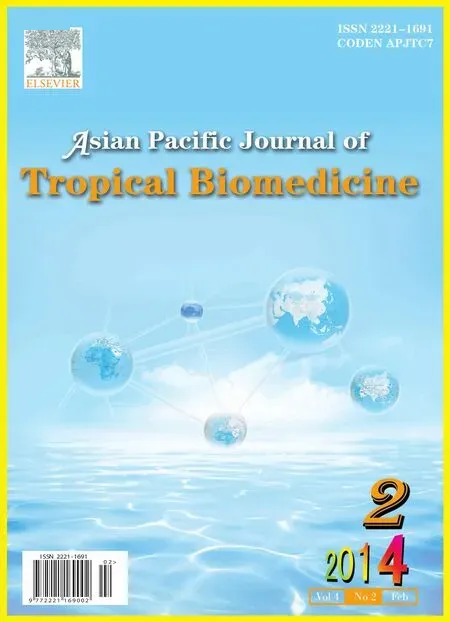 Asian Pacific Journal of Tropical Biomedicine2014年2期
Asian Pacific Journal of Tropical Biomedicine2014年2期
- Asian Pacific Journal of Tropical Biomedicine的其它文章
- Prevalence and antibiogram of bacterial isolates from urinary tract infections at Dessie Health Research Laboratory, Ethiopia
- Anti-inflammatory activity and qualitative analysis of different extracts of Maytenus obscura (A. Rich.) Cuf. by high performance thin layer chromatography method
- Ameliorative effect of alkaloid extract of Cyclea peltata (Poir.) Hook. f. & Thoms. roots (ACP) on APAP/CCl4induced liver toxicity in Wistar rats and in vitro free radical scavenging property
- Investigation of in vivo neuropharmacological effect of Alpinia nigra leaf extract
- A pharmacobotanical study of two medicinal species of Fabaceae
- Pancreatic islet regeneration and some liver biochemical parameters of leaf extracts of Vitex doniana in normal and streptozotocin-induced diabetic albino rats
